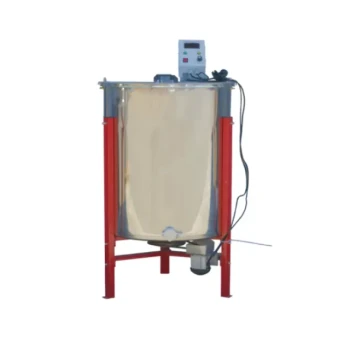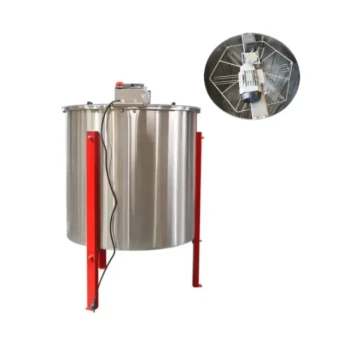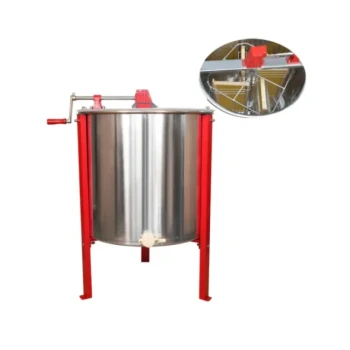The choice between a manual and an electric honey extractor comes down to one primary factor: the scale of your operation. For hobby beekeepers with fewer than 10 hives, a manual extractor is the most practical and cost-effective solution. For anyone managing more than 10 hives, an electric extractor becomes a necessary investment to save significant time and physical labor.
Your decision isn't just about manual vs. electric; it's about aligning your equipment with your time, physical capacity, and future beekeeping goals. A manual extractor prioritizes cost savings and simplicity, while an electric extractor prioritizes efficiency and scale.
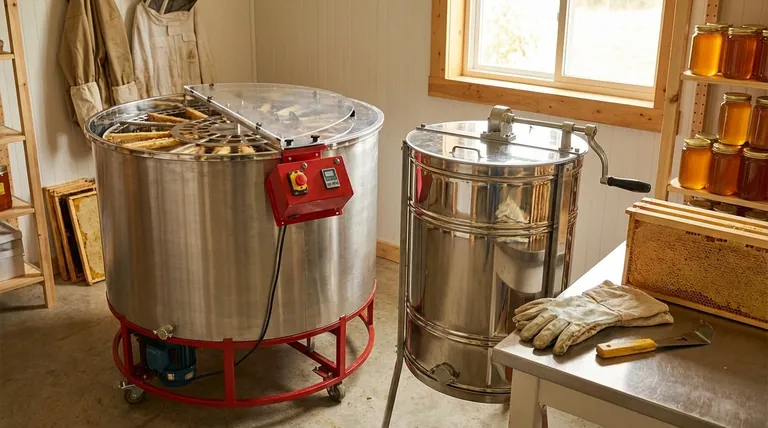
The Core Decision: Evaluating Your Scale
The number of hives you manage is the most reliable indicator of which extractor type will serve you best. The demands of harvesting from three hives are vastly different from harvesting from thirty.
The Hobbyist Scale (Under 10 Hives)
For a small number of hives, a manual extractor is perfectly suitable. The volume of honey is manageable, and the lower cost makes it an easy entry point.
You can extract honey without needing a power source, making it ideal for remote apiaries or off-grid setups.
The Commercial Scale (Over 10 Hives)
Once you manage more than 10 hives, the time and effort required for manual extraction become a significant burden. An electric extractor automates the most labor-intensive part of the harvest.
This speed and efficiency allow you to process large quantities of honey quickly, reducing a multi-day task to a matter of hours.
A Simple Sizing Guideline
As a rule of thumb, an extractor can typically support double the number of hives relative to its frame capacity.
For example, a 2-frame extractor is a good fit for up to 4 hives, while a 9-frame extractor can comfortably service an apiary of up to 18 hives.
Beyond Hive Count: The Key Factors
While hive count is the main driver, other practical considerations should influence your choice.
The Investment: Cost
Manual extractors are significantly less expensive than their electric counterparts. This makes them the clear choice for beekeepers on a strict budget or those who are just starting out.
Think of an electric model as an investment in your time. The higher upfront cost is paid back in saved hours and reduced physical strain over many harvests.
The Resource: Time and Labor
Do not underestimate the physical effort of manual extraction. Cranking the handle to get the frames spinning at sufficient speed is a real workout, especially over multiple batches.
An electric model runs on its own, freeing you to perform other tasks like unsealing the next batch of frames. This parallel workflow dramatically increases your overall efficiency.
The Material: Durability and Cleaning
Regardless of the type, stainless steel is the preferred material. It is far more durable than plastic, is food-safe, and is significantly easier to clean and maintain.
The Location: Power and Space
The most obvious difference is that an electric extractor requires a power source. If your extraction space is in a shed or barn without electricity, a manual extractor is your only option.
Additionally, larger-capacity electric models take up more storage space, a key consideration for those with limited room.
Understanding the Trade-offs
Neither option is perfect. Being aware of the inherent downsides will help you make a more informed decision.
The Downside of Manual Extractors
The primary drawback is the intense physical labor and time commitment required. As your apiary grows, a joyful harvest can quickly become an exhausting chore, potentially diminishing your enjoyment of beekeeping.
The Downside of Electric Extractors
The main barrier to an electric extractor is the higher initial cost. They are a more significant financial investment. Some models with fixed, high speeds can also be harsher on delicate new comb, so look for models with adjustable speed controls to mitigate this.
Making the Right Choice for Your Goal
Select your equipment based on a realistic assessment of your current needs and future ambitions.
- If your primary focus is cost-effectiveness for a few backyard hives: Choose a stainless steel manual extractor. It's the most sensible investment for small-scale beekeeping.
- If your primary focus is saving time and physical effort with a growing apiary: Invest in an electric extractor with adjustable speed. The efficiency gains will quickly justify the initial cost.
- If you are planning significant expansion in the near future: Consider purchasing an electric extractor that is slightly larger than your current needs demand to avoid having to upgrade again.
Ultimately, the best extractor is the one that makes your honey harvest a rewarding experience rather than a daunting task.
Summary Table:
| Factor | Manual Extractor | Electric Extractor |
|---|---|---|
| Best For | Hobbyists (< 10 hives) | Commercial (10+ hives) |
| Cost | Lower initial investment | Higher initial cost |
| Labor | High physical effort | Minimal physical effort |
| Speed | Slower, manual process | Faster, automated process |
| Power Needs | None required | Requires electricity |
Ready to streamline your honey harvest?
Whether you're a hobbyist looking for a reliable manual extractor or a commercial apiary needing the efficiency of an electric model, HONESTBEE has the right equipment for your scale. We supply durable, stainless steel extractors and other essential beekeeping supplies to commercial apiaries and distributors through our wholesale-focused operations.
Let's discuss your specific needs and find the perfect solution to save you time and labor.
Contact our expert team today for a quote!
Visual Guide
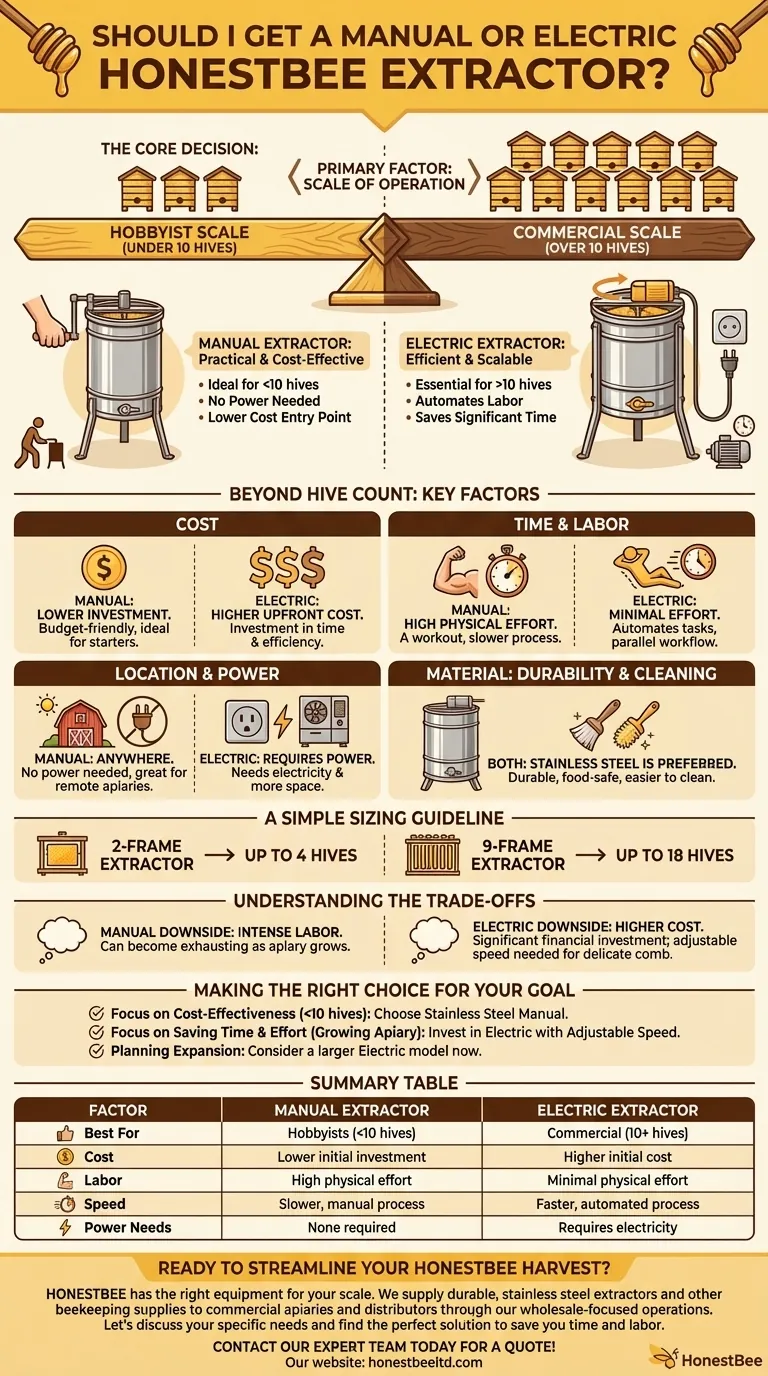
Related Products
- HONESTBEE 72 Frame Industrial Electric Honey Extractor for Beekeeping
- Professional 4 Frame Self Reversing Electric Honey Extractor for Beekeeping
- HONESTBEE 6 Frame Self Reversing Electric Honey Extractor for Beekeeping
- 8-Frame Electric Self-Reversing Honey Extractor Spinner for Commercial Honey Extraction Equipment
- 2 Frame Stainless Steel Manual Honey Spinner Extractor for Beekeeping
People Also Ask
- What are the two common types of honey extractors? Choose the Right Extractor for Your Apiary
- What are the advantages of automated honey extractors in terms of time efficiency? Boost Your Harvest Speed
- Why do beekeepers have to lift a lot of weight at the end of a growing season? The Reward of a Heavy Harvest
- How do automatic honey extractors function? Achieve High-Efficiency Honey Harvesting
- What are the advantages of automatic honey extractors? Scale Your Apiary with Unmatched Efficiency

